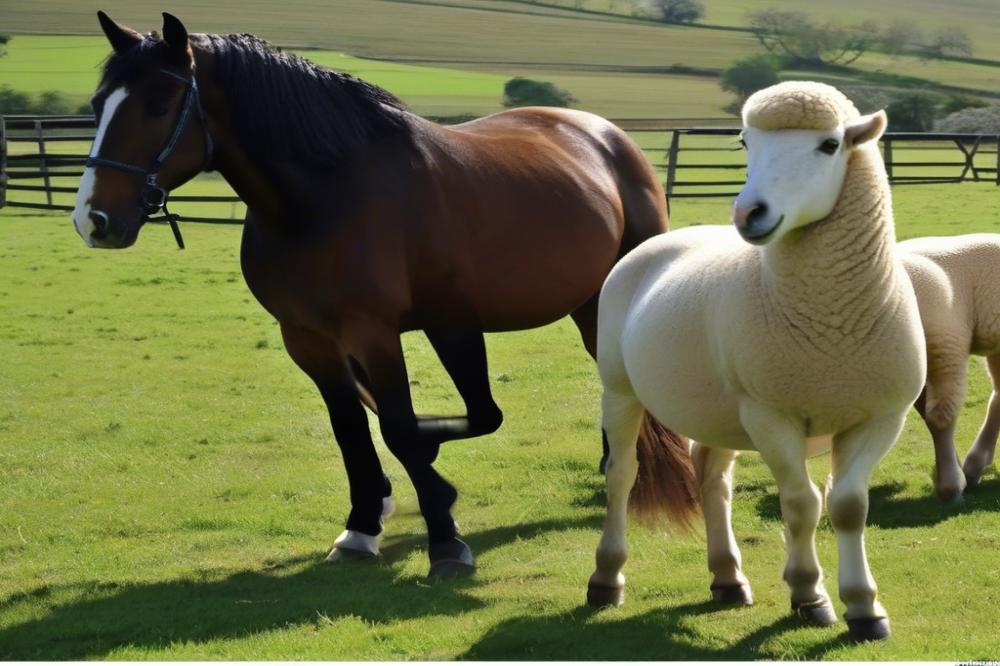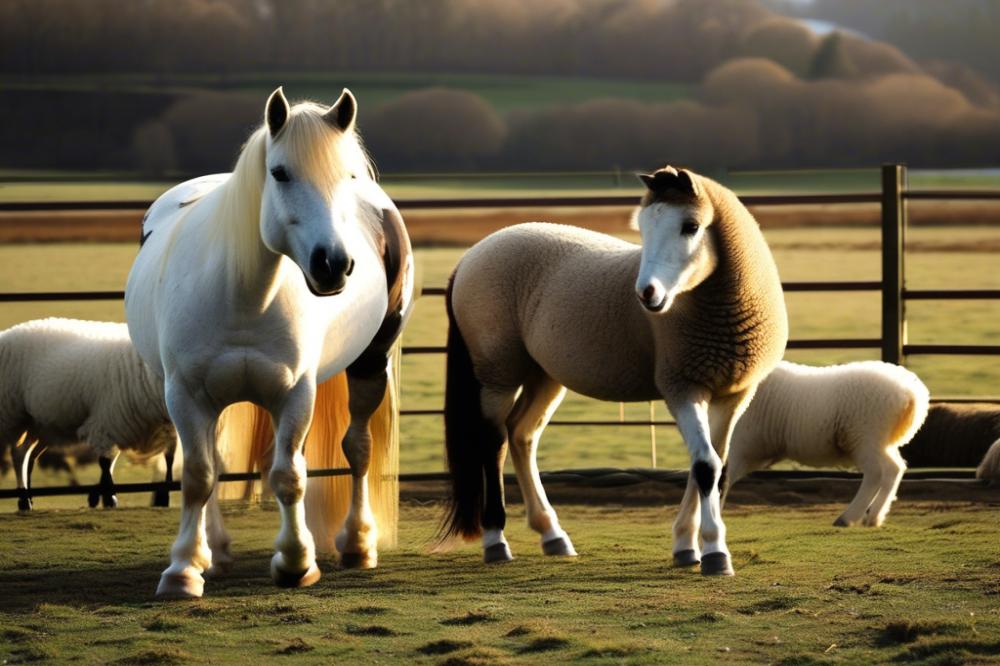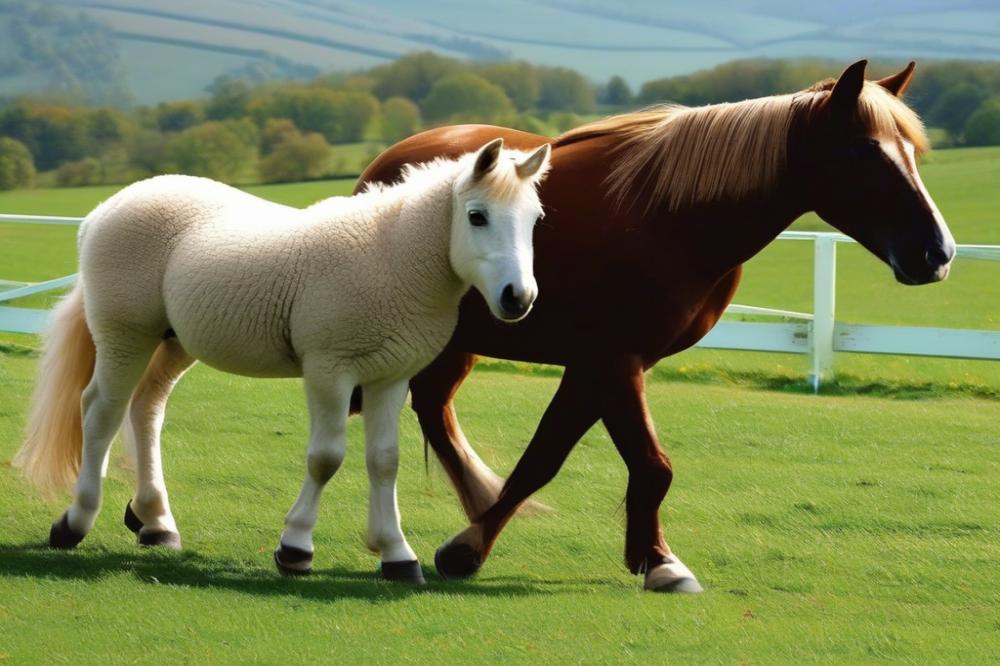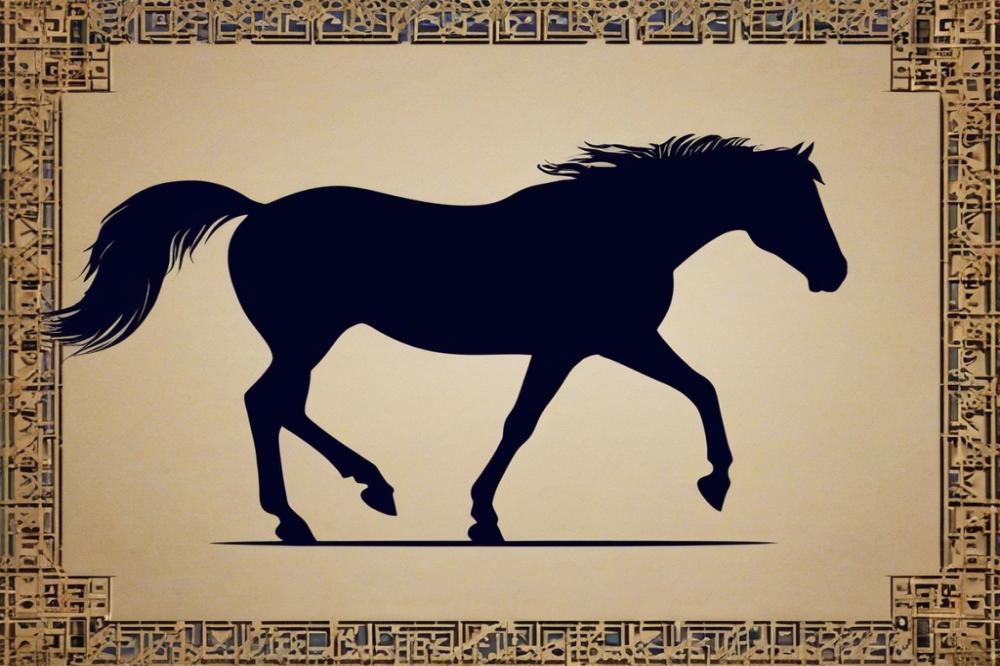Understanding Horse and Sheep Compatibility
When we think about animal compatibility, it’s easy to picture ferrets snuggling up to cats or dogs happily playing with their feathered friends. But what about horses and sheep? This unlikely pair paints a curious picture, doesn’t it? Horses and sheep can actually coexist peacefully, provided their needs and behaviors are carefully managed. In agricultural settings, their relationship can be beneficial for both, but it does come down to a bit more than just throwing them together in a field.
Importance in Agricultural and Equestrian Settings
Understanding horse care and management requires an awareness of how different animals interact. Farmers often look for synergies among various species, aiming to create a harmonious environment while maximizing productivity. Have you ever seen a shepherd leading a flock of sheep with a trusty steed? It’s a sight that highlights the potential for collaboration between these two animals. It’s like having a well-planned dance, where each partner knows their moves and supports the other.
In equestrian settings, the relationship can also benefit both animals. For instance, horses can help herd sheep, showcasing their remarkable equine behavior. However, this partnership isn’t all sunshine and rainbows. Care must be taken to monitor interactions closely. Just like you wouldn’t want a cat and a mouse sharing a cozy bed, the dynamics between a horse and a sheep can be tricky. Their distinct needs—as different as a mustang horse vs Arabian—require understanding and attention. A farmer’s thoughtful planning can lead to a cooperative arrangement that fosters peace in the pasture.
Besides, isn’t it a joy to witness animals working well together? A little bit of sheep munching grass here, and a horse gallivanting there can create a diverse and vibrant scene on a farm. As an added bonus, choosing the best trucks for horse trailers can make transporting these animals a whole lot easier. With some strategic thinking, farmers can effectively harness the strengths of both horses and sheep to promote not only animal compatibility but also a thriving agricultural environment.
Understanding Horse Behavior

Natural Instincts and Social Behavior of Horses
Horses have fascinating instincts. These creatures are prey animals. This means their survival often depends on being alert and cautious. They tend to be social beings, too. In the wild, they live in herds. That’s where they feel safe. Together, they can spot danger more easily. Observing this behavior helps us understand their basics.
Equine characteristics show that horses develop strong bonds with one another. If they’re raised together, they know each other’s habits. It is not uncommon for horses to nicker or whinny at their friends. This communication helps them feel connected. When they get anxious or scared, they might kick or bolt. It’s not because they are aggressive; they’re just responding to fear.
Understanding these traits allows for better horse care and horse management. Knowing how they behave around others aids in their overall well-being. Horses generally prefer familiar surroundings and companions. New animals in their space can signal a threat to them. Therefore, patience is key when introducing them to other animals.
How This Affects Their Interaction with Other Animals
Horses might not understand sheep right away. Their interactions can be quite amusing, too. Imagine a curious horse peering at a sheep. The fluffy creature, in turn, may stare back as if saying, “Who are you?” Animals usually gauge each other by behavior and sound. Horses stomp their hooves while sheep bleat. Despite their differences, a peaceful coexistence can occur.
Equine behavior varies widely among breeds. Some horses are more tolerant of different animals than others. For example, a calm Quarter Horse might just graze near a flock with little fuss. On the other hand, a skittish Thoroughbred may panic and run off. Each horse’s personality shapes their ability to adjust. Animal compatibility plays a major role here.
When introducing horses to sheep, always watch closely. You want to avoid stress for either party. If things go smoothly, the two may coexist well. However, without proper introductions, misunderstandings can happen. A horse might see a sheep as a strange moving object. Rest assured, with time and gentle guidance, they can learn to share a space.
Fear often drives behavior. Horses typically react first and think later. It’s part of their survival instinct. By remaining calm and supportive, handlers can guide them through new experiences. With patience and knowledge, it’s possible to create a harmonious environment. Just remember: a peaceful horse is a happy horse.
Understanding Sheep Behavior

Social Structure and Temperament of Sheep
Sheep are social animals that thrive in groups. Picture a family reunion where everyone knows their place. That’s how sheep behave; they have a hierarchy and prefer to stick with their flock. Ewes, or female sheep, often hold the leadership roles within the group. Rams, the males, may also have their moments of glory but mainly follow the lead of the ewes. This social structure helps them feel secure.
Temperament varies from one sheep to another. Some are mellow and calm, while others can be jumpy and nervous. It’s often said that a frightened sheep can behave like it has three left feet! When introduced to new environments or loud noises, they can panic easily. Their instincts drive them to flee rather than fight, which makes understanding their behavior essential in horse care and horse management.
Factors that Influence Sheep Behavior Around Horses
Several elements can shape sheep’s actions when interacting with horses. One factor is the size difference. Horses are much larger, and that can make sheep feel intimidated. Imagine being the smallest kid in gym class—it’s a bit nerve-wracking! When it comes to animal compatibility, the sheep’s reaction can depend on how calm the horse is. A gentle giant will likely put sheep at ease compared to a spunky, hyper horse.
Familiarity plays a role, too. Sheep tend to be more relaxed when they’ve spent time around horses. Like getting to know a new neighbor, it takes time to build trust. If they see horses regularly, they’ll adapt more easily. Equine characteristics also affect how sheep behave. Some horses may be playful, while others can be strong-willed. Understanding this can help handle situations smoothly.
Lastly, stressors in the environment contribute significantly. Odd sounds, quick movements, or even changes in the weather can set sheep on edge. Their flighty nature can make any unexpected disturbance feel like an alarm bell! For those managing both types of animals, knowing what unsettles sheep is crucial for maintaining harmony. Keeping the peace is like managing a schoolyard; everyone’s needs must be considered.
Benefits of Keeping Horses and Sheep Together

How They Complement Each Other on a Farm
Keeping these animals side by side can be a real ace up your sleeve. Horses carry a bit of flair and grace with their equine characteristics. Meanwhile, sheep add a touch of charm to the farmstead. Together, they create a vibrant ecosystem on any homestead. Their different temperaments can balance one another out. Where one might be a bit skittish, the other could be calm and collected. This mix can lead to a harmonious and lively atmosphere.
Shared Grazing and Land Management Benefits
Managing land with both species can be a game changer. Horses tend to graze more selectively, nibbling on the tastiest bits of grass. Sheep, on the other hand, don’t mind munching on denser foliage, helping to keep the pastures healthy. Each animal plays a role in maintaining the landscape. When they share grazing areas, it reduces the pressure on specific patches of land. Rotating them helps the soil recover naturally. This partnership can lead to greener pastures and thriving grass.
Economic Advantages of Dual Species Farming
Farming with both species offers some nice financial perks. Maintaining just one kind of animal can be costly in terms of feed and care. However, by combining them, farmers can reduce overall food costs. This happens because they utilize different grazing habits. Plus, there’s the added benefit of having two sources of income. Selling sheep wool or lambs alongside horses can boost profits significantly. It’s like hitting two birds with one stone. Keeping both animals together not only fosters friendship but can also lead to a more sustainable farm operation.
Potential Risks and Challenges
Behavioral Conflicts and Territorial Issues
Compatibility between different species can sometimes spark issues. Horses have certain behaviors that don’t always mesh well with sheep. Equine characteristics may include a natural instinct to be dominant. This can lead to some domination games or conflicts over food. Besides that, animals might feel the need to establish their own territory. When space is tight, a horse might stomp around a bit too aggressively for a sheep’s comfort. Conflicted signals can lead to anxious moments.
Many folks simply don’t realize how much personal space each animal requires. It can be tricky when both types roam in the same area. Disturbances might arise, especially during feeding time. Feeding should always be monitored to avoid squabbles. The last thing anyone wants is for fluffy sheep to get a little too close to a horse that’s not in the mood for visitors!
Health Risks and Disease Transmission Between Species
When it comes to health, mixed-species pastures require careful attention. Different animals can carry various diseases, and sharing space may increase the risk. For example, parasites can bounce from one to another if the same area is not properly managed. One sick horse can lead to sheep being affected too, and that’s no joke.
Sheep are known for their tendency to get worms, and if a horse picks up these nasties, the consequences can ripple through the flock. Also, not all vaccinations are the same. A horse may need certain shots that sheep don’t, which makes horse care and management even more crucial. Be vigilant about regular veterinary checkups to catch any potential health issues.
Tips for Preventing Negative Interactions
Preventing negative interactions is key to harmony. One major tip is to introduce them slowly. Allow both animals to get a whiff of each other before any actual meet-up. Supervision during their initial interactions can keep things calm. Giving each animal its own space helps to maintain a peaceful environment.
Feeding them separately is another smart approach. Placing food far from each other will help prevent disputes. Additionally, keep an eye on their body language. A horse’s flicking ears might signal irritation. Sheep may show nervousness if they start to bleat too much and dart around. These signals are important in understanding what’s going on. The right mix of care and attention can go a long way in ensuring they coexist peacefully.
It’s essential to remember that some animals might never become best buds. That’s perfectly okay! Sometimes the best friendship is a respectful distance. Just be patient with the process and have fun watching their interactions develop. After all, creating a friendly environment is a journey, not a race!
Best Practices for Co-Housing
Space Requirements and Environmental Considerations
When considering co-housing, space is king. Both animals need room to roam and graze. Horses need a bit more room than sheep, so plan accordingly. A good rule of thumb is to provide at least an acre for a small group of each. The land should be well-fenced to keep each species safe and secure. Jumping fences can be a horse’s favorite pastime. Even the best-behaved equine may try to get a closer look at fluffy friends. Natural barriers like trees or large rocks can help create a peaceful environment.
Also, think about the terrain. Horses love open fields, while sheep prefer more sheltered areas. Mixing these preferences can actually be beneficial. Healthy grasslands are perfect for both. However, watch for overgrazing. Rotating pastures can keep the land healthy and vibrant. A well-managed pasture makes all the difference in animal compatibility. Keep an eye on your space so it thrives for both species.
Feeding Schedules and Dietary Needs
Feeding times can be a real balancing act. Horses usually graze throughout the day, but they need hay and grain to stay healthy. Sheep, on the other hand, prefer a mix of grass, hay, and a bit of grain. Have you ever seen a sheep munching away like there’s no tomorrow? It’s quite the spectacle! Mixing feeds during the evening hours can minimize competition for food. Timing meals can create a peaceful and organized atmosphere.
Consider using feeding stations. Horses can munch away at hay while sheep nibble on their own special mix. Keep the feeding areas separate to avoid jealousy. Watch for any food-related squabbles. Horses can sometimes be pushy, especially at meal times. When everyone eats contentedly, it sets the tone for the rest of the day.
Shelter and Safety Measures for Both Species
Safety first! Both species need a warm and dry place to escape bad weather. Building a sturdy shelter is essential. Horses like wide-open spaces, and sheep prefer cozy corners. Design a shelter that caters to both their preferences. Sturdy walls, a good roof, and proper ventilation can keep everyone comfortable.
Be wary of shared toys or equipment. Horses can get a bit rambunctious, while sheep might be more delicate. A simple barrier can protect the sheep from boisterous play. You might even want to create separate lounging areas. That way, each animal can choose its favorite spot. Check for any hazards like sharp objects or unstable structures. Safety should always be part of horse care and management.
Taking care of these important details will help you create a happy and harmonious environment. An attentive eye and a little planning can make co-housing work beautifully.
Case Studies and Real-Life Experiences
Successful Partnerships
Many farmers have found that horse and sheep can coexist peacefully. One rancher, Sarah, has a small farm where she successfully keeps both animals. She often chuckles when her horse, Charlie, trots around the pasture while her sheep graze nearby. “It’s like watching a ballet,” she says, “with Charlie leading the dance and the sheep following along.”
The two animals have different equine characteristics. Horses are curious and sometimes playful. Sheep, on the other hand, have their own serene vibe. When these traits mix well, the results can be delightful. Sarah mentions that introducing the two groups took patience. “It wasn’t love at first sight,” she laughs. “But after a few weeks, they just seemed to get each other.”
Insights from the Field
Another farmer, Mike, shares his experiences with animal management. He talks about how careful horse care made all the difference. Initially, Mike worried about equine behavior around his sheep. To ease his fears, he monitored interactions closely. Days turned into weeks, and soon, he saw them sharing the same space without any issues. “Now, I can’t imagine my farm without both of them,” he says proudly.
Mike describes a humorous incident where one of the sheep, named Fluffy, took a curious stroll over to his horse. “Fluffy thought he was a big shepherd or something,” Mike jokes. The horse seemed unfazed and just continued munching on hay. These moments highlight the quirky bond that can form when thinking about animal compatibility.
Voices from the Community
Farmers often offer practical advice based on their experiences. One common tip includes starting with young ones. By introducing young horses and lambs together, it helps establish friendships early on. A caring attitude promotes better relationships and smoother interactions.
Several ranchers emphasize the importance of a well-planned environment. They suggest creating separate areas for feeding and resting. This helps avoid competition for resources. Having enough space encourages harmony. Many farmers believe this setup minimizes stress for both types of animals.
Reading stories from local farmers brings insight. Their shared experiences create a community rich with knowledge. In many cases, compatibility can surprise even the most skeptical ranchers. A little patience and understanding can go a long way. So, if you’re considering adding some sheep to your equine crew, it might just be worth a shot!
Final Thoughts on Horse and Sheep Living Together
As we wrap up our discussion on compatibility between horses and sheep, let’s take a moment to recap both the benefits and challenges of their co-housing. When they share a space, these two animals can create a lively farmyard atmosphere, not unlike a mixed group of friends at a picnic. Each brings its own unique traits to the table, which can lead to a harmonious living arrangement. For instance, while horses might tower over sheep, their gentle demeanor often encourages a sense of safety in the flock.
On the flip side, challenges can arise. Horses can sometimes be a bit clumsy and rambunctious, which might leave other occupants feeling a tad nervous. Have you ever seen a horse diving into a spontaneous roll in the grass? It can be amusing but might spook nearby sheep. Additionally, there can be issues with food as horses require different rations compared to a grazing flock. Make sure to keep food sources separate to avoid conflicts and make meal times run smoothly.
For successful co-housing, many best practices shine through. First, providing enough space is key. Giving each species room to roam helps minimize stress and drama. Another tip? Keep a close eye on weather changes, especially during colder months. You might wonder, do horses shiver when cold? To keep them comfortable, consider investing in proper bedding and maybe even a blanket for your equine friend as the temperature drops.
Lastly, regular checking in on their interactions can make a world of difference. Just like human friendships, animal relationships need nurturing. Sometimes, it’s just a matter of observing from the sidelines and stepping in if things get a little too rowdy. With a good balance of patience, care, and a sprinkle of humor, these two species can enjoy a friendly coexistence. So next time you see horses and sheep together, remember that with the right practices, they can truly be the best of pals!



